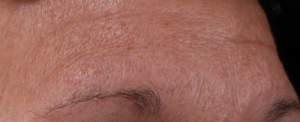Rethinking Anti-Ageing Serums
Our aim here at Medico Beauty is to educate our aestheticians, customers and readers on everything from new scientific innovations, product technologies, to treatment protocols and more. We wanted to highlight the below article, as it is a topic that our Skin Cop, Constance Campion has been talking about for some time. Our articles will tend to be scientifically-based, but a good solid understanding of retinoids and how far they've come will help the aesthetician make strides in treating their clients...and those of us that are on the other side of the treatment table, the information of course just makes you a much more aware consumer.
[caption id="attachment_2894" align="alignright" width="125"] Noureddine Mriouah, Product Development Director & Scientist[/caption]
Noureddine Mriouah, Product Development Director & Scientist[/caption]
******
In a market that is flooded with so-called “miracle products,” it has become increasingly difficult for skincare professionals and their clients to separate the scientific wheat from the marketing chaff. However, despite the product fads and buzzwords, one ingredient family remains the gold standard in anti-aging, and with good reason. Retinoids are the most efficacious ingredients proven to stimulate fibroblasts—promoting collagen and elastin production to significantly reduce the appearance of lines and wrinkles. Backed by decades of clinical research, retinol and its derivatives remain the closest thing skincare companies have to a “fountain of youth.”
However, there is a catch. So powerful and reactive is this wonder ingredient, that it is often its own worst enemy, degrading rapidly in light and oxygen and causing irritation in large doses. Fortunately, as researchers continue to unravel the mechanisms of how retinoids work, they are able to offer product developers inventive, new solutions to many of their inherent challenges. By rethinking retinoids, science comes ever closer to creating a true skincare miracle. Retinol and the Human Body
The human organism is made of multiple interconnected organs, each communicating with each other through messengers and direct connections such as vascularization. This complex and fragile system needs protection from harmful environmental aggressors, such as UV radiation, toxic substances and oxidation. As the body’s first line of defense against external threats, the skin assumes this protective role. Unfortunately, being a very active organ, it is also the first to suffer from these aggres¬sions, as seen in the formation of wrinkles, loss of elasticity and even—in extreme instances—skin cancer.
There are various components within the skin’s layers responsible for modulating and regulating these processes. Among them, retinol and its derivatives are essential in the destruction of free radicals and maintaining the skin’s healthy look.
R E T I N O I D S
Retinol (Vitamin A) and its natural and synthetic derivatives are collectively known as retinoids. Retinaldehyde (aka retinal), retinoic acid and retinyl esters are all part of the retinoid family. Of all the members of the retinoid family, only retinoic acid is biologically active. Retinol, the most common form of retinoid in skin care, is obtained either directly from certain foods, such as fish oil and liver, or indirectly from carotenoids (found mainly in fruits and vegetables, such as carrots, melons, apricots, mangoes, spinach and tomatoes). With the help of enzymes, it is then converted to retinal for membrane transport. To be effective, retinal is then converted into retinoic acid for target cell delivery.
Retinoids are required for a vast number of biological processes. In particular, they are involved in embryogenesis, reproduction, vision, growth, inflammation, cellular differentiation, proliferation, apoptosis, immune system, reproduction and the proliferation and differentiation of the epithelia.
A P P L I C A T I O N I N D E R M A T O L O G Y & C O S M E T O L O G Y
Retinoids have been used for many years in the treatment of actinic keratosis, seborrhea, acne vulgaris, ichthyosis, psoriasis, lichen, precancerous lesions and skin melanomas and UV-induced skin ageing. The mechanisms of action of retinoids on the skin are still the subject of research, but certain facts have been clearly established. Regarding the epidermis, retinoids play an important role in the proliferation of epidermal cells, keratinization and desquamation. At the dermal level, they influence fibroblast proliferation and collagen metabolism. During the inflammatory response, they show immune-modulatory activity and may prevent tum our growth.
While retinoids—and retinol in particular—are among skincare’s most popular ingredients, they nevertheless pose certain problems to product developers. Quick to degrade, difficult to deliver and irritable in high concentrations, retinoids require additional considerations to ensure optimal performance and minimal irritation. Such added attention, however, comes at a price. As a result, skincare companies are often forced to choose between an enhanced ingredient and keeping production costs manageable.
our growth.
While retinoids—and retinol in particular—are among skincare’s most popular ingredients, they nevertheless pose certain problems to product developers. Quick to degrade, difficult to deliver and irritable in high concentrations, retinoids require additional considerations to ensure optimal performance and minimal irritation. Such added attention, however, comes at a price. As a result, skincare companies are often forced to choose between an enhanced ingredient and keeping production costs manageable.
F O R M U L A T I N G W I T H R E T A N O I D S
Besides irritability, retinoids bring many challenges to skin care formulation, including water insolubility and chemical instability. Retinol and its derivatives are hydrophobic compounds that are liposoluble. They come in the form of crystals or oily solutions that are insoluble in water but soluble in organic solvents, such as alcohol. They are also highly unstable in the presence of oxygen and other oxidants and are highly sensitive to light. While stable in alkaline environments, retinoids are very sensitive to acidic conditions.
Chemists have proposed several solutions to improve the stability of retinol and its derivatives. Among them is the use of UV-protective packaging and the addition of antioxidants, such as tocopherols, ascorbic acid, butyl-hydroxyanisole (BHA) or butyl-hydroxytoluene (BHT). Regarding the problem of solubility, other solutions include the use of different vehicles, such as emulsions and micro-emulsions. Other solid supra-molecular structures, such as microspheres and microcapsules (which are generally made of polymers), allow the incorporation of retinoids by improving their stability, solubility and, at the same time, their delivery.
G E T T I N G T H E B E S T F R O M R E T A N O I D S
When it comes to developing new retinoid formulas, many skincare companies seem satisfied to “take the good with the bad.” However, an enterprising few have risen to the retinoid challenge, applying bold new techniques to temper the negative aspects of this essential ingredient.
One particularly promising avenue is encapsulation. Chemists have also found that combining retinol (or even more active retinal) with certain lipoproteins, glycoproteins, glycosaminoglycans (GAGs) and other natural plant-based amphiphilic com¬pounds can help overcome the challenge of permeating both water and oil-based cellular barriers as well as the challenge of problematic irritation. In this case, multiple water- and lipid-soluble layers act as alternating keys, each allowing the transported ingredient—the retinoid—to pass deeper into the skin with less irritation.
Such encapsulation techniques have also shown to reduce a retinoid’s trademark irritation. By minimizing the risk of adverse reaction, product developers can now increase retinoid concentration, and subsequently product efficacy, without the discomfort one once expected.
Combined with intelligent encapsulation, the addition of GAGs, glycopropteins and lipoproteins has helped to create a new generation of retinoid that’s more effective and stable than ever before while rendering irritation a thing of the past. Thanks to the innovative thinking of a few cutting-edge skincare companies, the future of retinoids is now.
6 WEEKS WITH SERUM 16
[caption id="attachment_2892" align="aligncenter" width="300"] BEFORE: SERUM 16, DAY ONE[/caption]
[caption id="attachment_2893" align="aligncenter" width="300"]
BEFORE: SERUM 16, DAY ONE[/caption]
[caption id="attachment_2893" align="aligncenter" width="300"] AFTER: SERUM 16, 6 WEEKS[/caption]
AFTER: SERUM 16, 6 WEEKS[/caption]
Leave a comment